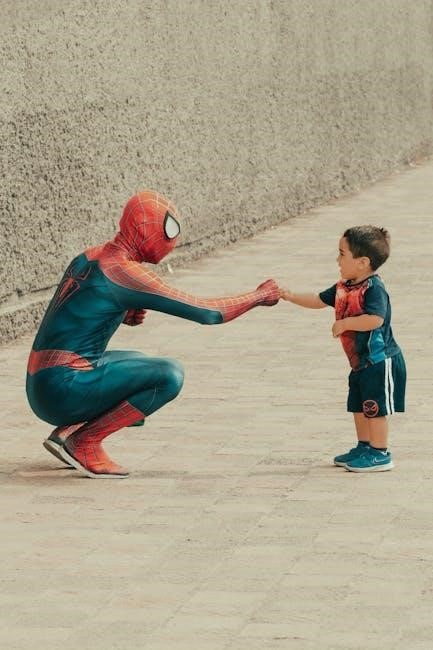Discover the fundamentals of comic art through Stan Lee’s iconic guide, first published in 1978․ This legendary book offers insights into creating dynamic characters, storytelling, and visual techniques, making it a cornerstone for aspiring comic artists․
Overview of the Marvel Way
The Marvel Way, as outlined by Stan Lee, is a comprehensive approach to comic art emphasizing dynamic storytelling, visual appeal, and character development․ It combines practical techniques with creative principles, guiding artists from basics to advanced skills․ This method has become a cornerstone for both beginners and professionals, offering timeless insights into crafting compelling comics․ Its legacy continues to inspire artists worldwide, making it an essential resource for mastering the medium․
Importance of Stan Lee’s Guide
Stan Lee’s guide is a seminal work in comic art education, offering unparalleled insights into the Marvel method․ It bridges the gap between creativity and technique, providing a structured approach to drawing and storytelling․ Lee’s expertise, honed through decades of shaping iconic characters, makes this guide indispensable for anyone aiming to master comic art, ensuring its relevance and impact across generations of artists and fans alike․

Understanding the Basics of Comic Art
Mastering comic art begins with understanding anatomy, perspective, and proportion․ These basics are essential for creating dynamic, engaging visuals that capture the reader’s attention․

Using reference materials and tools like art gum and erasers can enhance your drawing skills, helping you refine your craft and bring your stories to life․
Comic book anatomy involves understanding the structure of panels, pages, and storytelling elements․ Panels must be visually engaging, guiding the reader’s eye through the narrative seamlessly․ The arrangement of text and images is crucial, ensuring clarity and flow․ Proper anatomy enhances storytelling, making each page dynamic and immersive for readers․
Understanding Perspective and Proportion
Mastering perspective and proportion is essential for creating visually engaging and believable comic art․ Perspective adds depth and dimension, while proportion ensures characters and objects are accurately scaled․ Using reference lines and grids can help maintain consistency․ Properly applied, these techniques guide the reader’s eye and enhance storytelling, making scenes dynamic and immersive․
Tools and Materials for Drawing Comics
Essential tools include pencils, erasers, sharpener, and high-quality paper․ Digital drawing tablets are optional but enhance efficiency․ Proper materials ensure crisp lines and professional results for artists;
Essential Drawing Tools
The Marvel Way emphasizes traditional tools like graphite pencils, erasers, and sharpener for precision․ Digital tools are optional but can enhance workflow․ High-quality paper ensures clean lines and professional results․
Setting Up Your Workspace
A well-organized workspace is key to productivity․ Use a sturdy drawing board with pushpins to secure paper, ensuring stability․ Keep essential tools like pencils, erasers, and sharpener within easy reach․ Maintain a clean environment to focus on creativity and precision, fostering an efficient workflow for comic art creation․
Developing Your Comic Drawing Style
Develop your unique style by practicing regularly and studying reference materials․ Stan Lee’s guide emphasizes mastering techniques to create dynamic, engaging comic characters and stories․
Creating Dynamic Characters
Start with basic forms like cylinders and cubes, as Stan Lee suggested, to build proportion and balance․ Exaggerate features for impact, ensuring characters are recognizable from any angle․ Focus on dynamic poses and expressive faces to convey emotion․ Practice anatomical accuracy while adding unique personality traits․ Use reference materials to refine details․ Remember, Marvel characters are iconic, so aim for simplicity and storytelling through visuals, making your characters unforgettable and engaging for readers․
Mastering Action and Movement
Bring energy to your comics by capturing dynamic poses and motion lines․ Use exaggerated expressions and fluid body language to convey action․ Experiment with panel composition to guide the reader’s eye․ Practice gesture drawing to freeze motion in compelling ways․ Reference real-life movements and study how Marvel artists balance detail with simplicity․ Remember, movement should tell a story, making each scene vibrant and engaging for the reader․

Storytelling Through Comics
Stan Lee’s guide emphasizes storytelling as the heart of comics; Learn how to weave narratives visually, balancing text and art to engage readers emotionally and intellectually․
Panel Layout and Composition
Mastering panel layout is crucial for visual storytelling․ Stan Lee’s guide highlights the importance of arranging panels to guide the reader’s eye seamlessly through the narrative․ Keep layouts clean and balanced, ensuring text and images complement each other․ Reference materials can help refine compositions․ Practice drawing panels daily to enhance storytelling flow and pacing, making your comics more engaging and visually dynamic for readers․
Integrating Text and Visuals
Effectively combining dialogue, captions, and art is key to engaging storytelling․ Ensure text complements visuals without overcrowding panels․ Start with a clear story line, identifying visually interesting key moments․ Balance text placement to maintain readability and flow․ Practice integrating these elements seamlessly, using reference materials to refine your technique․ This harmonious blend enhances the narrative, making your comic more immersive and visually appealing for readers․

Advanced Techniques for Comic Drawing
Explore advanced shading, texture, and color techniques to enhance visual depth and storytelling impact in your comic art․
Shading and Texture
Mastering shading and texture enhances the depth and realism in your comic art․ Use various tools like pencils, inks, and digital software to create intricate details․ Start with basic shading techniques to add volume to characters and objects․ Texture adds visual interest, making scenes more immersive․ Practice layering shadows and highlights to achieve dramatic effects․ Regular exercises will refine your skills, making your artwork stand out․
Color Theory for Comics
Color theory is a key element in comic art, enhancing mood and visual appeal․ Use contrasting colors to guide the reader’s eye and create dynamic scenes․ Warm tones can evoke action, while cool tones establish calm․ Experiment with color wheels to find harmonious palettes․ Digital tools now simplify color application, but traditional techniques remain foundational․ Practice balancing colors to make your artwork visually striking and engaging for readers․
Practice and Improvement
Regular drawing exercises and using reference materials are essential for growth․ Stan Lee’s guide emphasizes consistent practice to refine skills and develop a personal style effectively․
Regular Drawing Exercises
Consistent practice is vital for improving comic art skills․ Stan Lee’s guide recommends daily exercises, starting with basic anatomy and progressing to complex poses․ Dedicate 30 minutes daily to sketching, focusing on proportions and dynamics to build a strong foundation․ Regular drills help refine techniques, ensuring consistent growth and mastery over time․
Using Reference Materials
Reference materials are crucial for creating accurate and dynamic comic art․ They help artists capture realistic anatomy, poses, and expressions․ Stan Lee’s guide emphasizes the importance of observation and real-world study․ Essential references include anatomy books, life drawings, and photo references․ By studying these, artists can refine their skills and ensure consistency in their work․ Regular use of references enhances detail and authenticity in every panel;

Resources for Learning
Explore essential resources like Stan Lee’s How to Draw Comics the Marvel Way PDF and online tutorials for mastering comic art techniques and storytelling․
How to Draw Comics the Marvel Way PDF
Stan Lee’s How to Draw Comics the Marvel Way is a seminal guide for comic artists, offering insights into character creation, storytelling, and visual techniques․ First published in 1978, it remains a cornerstone for learning comic art․ The PDF version provides easy access to its timeless lessons, covering anatomy, perspective, and dynamic illustration․ It’s a must-have resource for both beginners and professionals aiming to refine their craft․
Online Tutorials and Communities
Online tutorials and communities offer invaluable resources for mastering the Marvel Way of drawing comics․ Platforms like YouTube and Skillshare provide step-by-step guides, while communities such as DeviantArt and Reddit connect artists globally․ These spaces allow for feedback, inspiration, and collaboration, helping creators refine their skills and stay updated on industry trends․ They complement the PDF guide, offering dynamic learning opportunities for aspiring comic artists․
Creating a Portfolio and Career Steps
A strong portfolio is your gateway to professional opportunities, showcasing your best work․ Use Stan Lee’s guide to refine your craft and network with industry professionals online․
Building a Strong Portfolio
Your portfolio is a showcase of your artistic skills and versatility․ Include a variety of pieces that highlight your ability to draw dynamic characters, action scenes, and storytelling․ Focus on quality over quantity, ensuring each piece demonstrates your mastery of comic art techniques․ Regularly update your portfolio with new work to reflect your growth․ Consider creating both physical and digital versions for easy sharing with publishers and online communities․
Pursuing a Career in Comic Art
To break into the comic industry, focus on developing a professional portfolio and networking with industry professionals․ Consider starting as a freelance artist or submitting work to publishers․ Attend comic conventions and join online communities to connect with creators and editors․ Persistence and continuous improvement are key to landing opportunities․ Explore various roles, from penciling to inking, and stay updated on industry trends to grow your career in comic art․